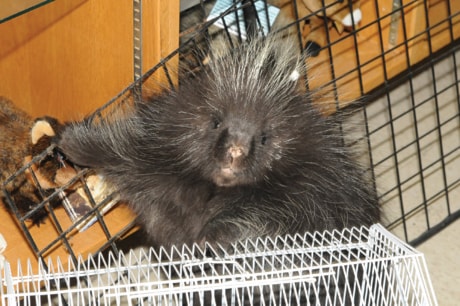One night last May, an RCMP officer accidently drove over a female porcupine on a road near Rimbey. Upon inspecting the mother’s splayed corpse, the officer noticed the squiggling movements of a baby.
He performed an impromptu caesarean and carefully wrapped the little porcupette in a blanket.
The next day, he took the tiny whimpering creature to the Medicine River Wildlife Centre (MRWC) where Charlie — named in the cop’s honour — has delighted the world ever since.
Without a mother to teach him about porcupine protocols and how to survive in the wild, Charlie cannot be released. So the centre staff obtained permission to retain him as an educational animal, and he will spend his natural life as an ambassador for both his species, the centre itself, and all local wildlife.
He will be displayed in a well-controlled (no-touch) environment, of course, since he still has quills. But giving people the opportunity to see him up close will, we hope, help assuage the widespread prejudice that most folks hold against these skulking denizens of the night.
Like most rural Albertans, I grew up disliking porcupines. They girdled our fruit trees, chewed on the outhouse and destroyed some saddles.
Worse yet, they “quilled” our dogs repeatedly.
I have since learned that these unjustly maligned creatures are both interesting and intelligent. They have a gentle temperament, they exhibit quite fascinating behaviours (their courtship rituals border on the bizarre), and they are clever enough to retain detailed mental maps of their home territories.
Contrary to what is commonly believed, they do not “throw” their quills. In fact, they will strike as a last resort and only after issuing two other obvious warnings — a loud teeth chatter followed by the release of a foul-smelling liquid.
There is little doubt that porcupines would be less vilified if only dogs would learn to leave them alone!
The porcupines’ insatiable appetite for salt is because of their sodium-deprived herbivorous diet.
It has been reported that a block of livestock salt, set well away from a building site, will satisfy their cravings and thus reduce their penchant for gnawing on plywood, implement handles and other salty delights.
The next time you see a porcupine, especially if it is in a tree, take some time to observe it.
If you are quiet and gentle, most porcupines will allow you to approach close enough to get a good look at their remarkable feet (which are well-adapted for clutching and climbing), amazing hair (they actually have five types of hair—quills, under-tail bristles, whiskers, guard hairs and fur) and soft faces (which are downright adorable).
Myrna Pearman is a biologist and site manager at the Ellis Bird Farm. contact her at nfo@ellisbirdfarm.ca.
